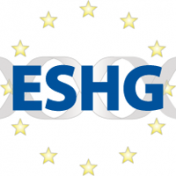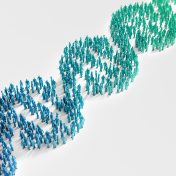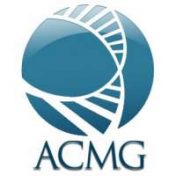The recent release of VSClinical gives users the ability to evaluate variants based on the 33 criteria according to the American College of Medical Genetic and Genomics (ACMG) guidelines. This feature leverages a variety of variant sequencing evidence including population data, functional data, and computational predictions while providing rich visualizations and auto recommendations to help answer challenging criteria. This highly… Read more »
We’re looking forward to seeing everyone at ESHG 2018 in Milano, Italy. Both Gabe Rudy and I will be representing the Golden Helix Team and hope that you will stop by to say hello! We will be in booth #312 which I’ve highlighted in the photo below: As always, we have put together a series of quick, in-booth demos that… Read more »
In our previous webcast, we discussed the splice site algorithms for clinical genomics within VSClinical. We took it a step further in yesterday’s webcast and looked at the functional predictions and conservation scores. We had a great turnout for this event with lots of great questions from the attendees. I’d like to recap our Q&A for anyone else who might… Read more »
We are incredibly honored to be recognized as one of the Top 10 Analytics Solution Providers of 2018 by Pharma Tech Outlook. “Through innovative products, Golden Helix has been simplifying the clinical workflows and genomic testing for numerous labs. For instance, Prevention Genetics, a clinical testing laboratory offering genetic and DNA banking services with the largest menu of gene sequencing… Read more »
Streamlining the ACMG Guidelines and Providing Scoring Recommendations As we discussed in our recent webcast on VSClinical, the process of scoring the ACMG guidelines requires evaluating evidence for the connection between a variant and the disorder or condition being evaluated by the genetic test for an individual. These lines of evidence cover clinical presentation, gene function, bioinformatic annotations and in-silico… Read more »
Functional Predictions and Conservation Scores in VSClinical Several algorithms have been developed to predict the impact of amino acid substitutions on protein function and quantify conservation of nucleotide positions. These methods provide vital supporting evidence to clinicians when interpreting variants in accordance with the ACMG guidelines. The two most popular functional prediction algorithms are SIFT and PolyPhen2, while the most… Read more »
Revisiting the Five Splice Site Algorithms used in Clinical Genetics Interpretation of variants in accordance with the ACMG guidelines requires that variants near canonical splice boundaries be evaluated for their potential to disrupt gene splicing [1]. The five most common tools for splice site detection are NNSplice, MaxEntScan, GeneSplicer, HumanSplicingFinder, and SpliceSiteFinder-like. Because these algorithms have been made easily accessible… Read more »
In the last installment of this series, I covered the basics of variant interpretation and how it fits into the genomic testing process. Now we can cover in more detail how VSClinical works, what algorithms and annotation sources power the recommendations and how the ACMG criteria are organized into useful categories. VSClinical is built to make the process of evaluating… Read more »
This week we launched VSClincial with our first webcast to show our powerful new way to perform variant interpretation following the ACMG guidelines. Our audience asked a lot of great questions on the new product and I’d like to highlight a few here. Can VSClinical run on a laptop and/or a locked down environment? Like all of Golden Helix products, you have… Read more »
Yesterday we launched VSClincial with our first webcast in what will be a series about this powerful new way to perform variant interpretation following the ACMG guidelines. In this post, I wanted to cover the motivation for VSClinical and how we curated and presented the 33 criteria from the ACMG Guidelines into an intuitive workflow with various bioinformatic evidence and… Read more »
We just came back from ACMG in North Carolina where we launched our new product VSClinical. The reception has been terrific and our booth has never been as frequented. We had record level visitors and demo presentations. So, what is all that buzz about this new product? Why do people care so much and how does it help a clinical… Read more »
We’re looking forward to seeing you all at the ACMG 2018. This year the Golden Helix Team will be represented by President & CEO, Andreas Scherer, Senior Product Engineer, Nathan Fortier, and myself, Marketing Manager, Delaina Hawkins. Make sure to stop by and say hello! You can find Golden Helix in booth #1306: We’ve put together a series of quick, in-booth demos… Read more »
The clinical interpretation of variants is time-consuming and requires attention to details. Clinicians are being asked to thoroughly review any variants that could potentially cause disease. There are guidelines for the interpretation of variants relating to hereditary risk, germline diagnostics, and molecular oncology panels, such as those issued by the American College of Medical Genetics (ACMG), which are nationally and internationally… Read more »
ClinVar is the NCBI variant database that focuses on the categorizing of variant alleles and their interpretation from a clinical standpoint. This has made it a great resource, especially for those seeking variant allele disease correlations and pathogenicity. And this all worked fairly well, but it was changed… Previously, the ClinVar variant track annotation took some time to curate due… Read more »
Ready to take your analysis to the next level? Our Small-Lab VarSeq PowerPack enables users to move their analysis from FASTQ to clinical reporting through one streamlined pipeline. Here’s what’s included: VarSeq VarSeq is an intuitive, integrated software solution for tertiary analysis. With VarSeq you can automate your workflows and analyze variants for gene panels, exomes, and whole genomes. VS-CNV… Read more »
Sentieon TNscope is a platform dedicated to the identification of tumor-normal somatic variants including single nucleotide variation (SNV), indel, as well as structure variations (SVs). In our recent webcast, Dr. Donald Freed, Bioinformatics Scientist at Sentieon, gave viewers an exclusive overview of the platform. The webcast generated a lot of great questions which I would like to share with you… Read more »
I would like to congratulate our third and final winner of the 2017-18 Abstract Competition, Suxu Tan, a current PhD Student at Auburn University. Our first and second place winners, Michael Iacocca and Nicole Weaver, performed their research using VarSeq. Suxu, however, used SVS to conduct the research in his paper ‘GWAS analysis of QTL for resistance against Edwardsiella ictaluri in… Read more »
I hope you were able to join us for last week’s webcast where we invited first-place abstract competition winner Michael Iacocca to present on his submission “Using NGS to detect CNVs in familial hypercholesterolemia”. Today, I’d like to announce our second-place winner, Nicole Weaver, Clinical Geneticist at Cincinnati Children’s Hospital. Nicole adopted VarSeq into her research pipeline in 2015 and… Read more »
First-place Abstract Competition Winner, Michael Iacocca, shared his research with the Golden Helix Community during our February webcast ‘Using NGS to detect CNVs in familial hypercholesterolemia‘. In this webcast, he gave a great explanation on how our CNV caller aided his team in their research. If you were unable to join us for the event, you can find a recording… Read more »
Relating human phenotypes to genotypes is the name of the game with OMIM, and as their website says, “is intended for use primarily by physicians and other professionals concerned with genetic disorders, by genetics researchers, and by advanced students in science and medicine.” The Online Mendelian Inheritance in Man (or OMIM) was originally created by Dr. Victor A. McKusick in… Read more »














